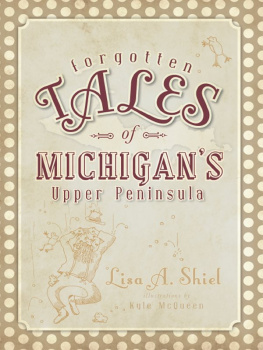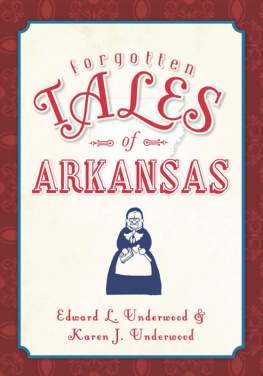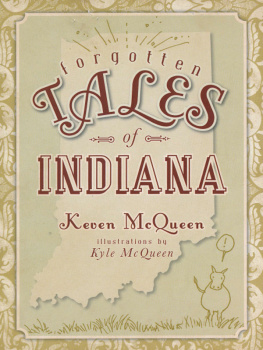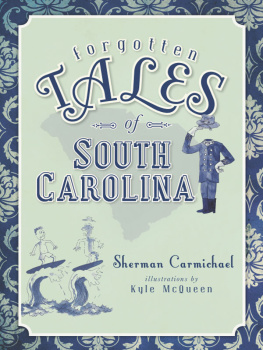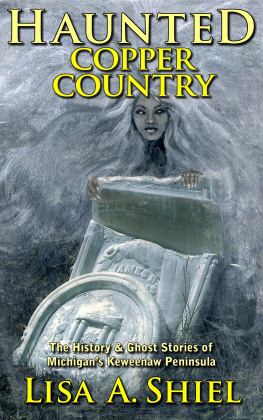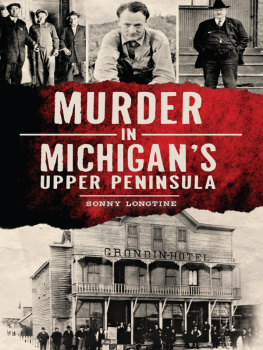

Published by The History Press
Charleston, SC 29403
www.historypress.net
Copyright 2010 by Lisa A. Shiel
All rights reserved
First published 2010
e-book edition
ISBN 978.1.61423.601.6
Library of Congress Cataloging-in-Publication Data
Shiel, Lisa A.
Forgotten tales of Michigans Upper Peninsula / Lisa Shiel.
p. cm.
Includes bibliographical references.
print edition ISBN 978-1-59629-916-0
1. Upper Peninsula (Mich.)--History--Anecdotes. 2. Upper Peninsula (Mich.)--Social life and customs--Anecdotes. 3. Upper Peninsula (Mich.)--Biography--Anecdotes. I. Title.
F572.N8S55 2010
977.49--dc22
2010025548
Notice: The information in this book is true and complete to the best of our knowledge. It is offered without guarantee on the part of the author or The History Press. The author and The History Press disclaim all liability in connection with the use of this book.
All rights reserved. No part of this book may be reproduced or transmitted in any form whatsoever without prior written permission from the publisher except in the case of brief quotations embodied in critical articles and reviews.
Contents
Introduction
In 1836, before becoming a state in January 1837, Michigan fought a pseudo-war against Ohio over possession of a strip of land that included Toledo. The Toledo War ended when Michigan agreed to give up the Toledo Strip in exchange for two things: statehood andin hindsight, more importantlythe territory known as the Upper Peninsula (UP). At the time, citizens of Michigan may have had their doubts about who came out on top, but soon the riches and wonders of the UP became evident. The northern peninsula would attract miners, con men, tycoons and literal gold diggers.
Today, residents of the Upper Peninsula call themselves Yoopers and celebrate their distinctiveness. In the old days, folks who moved to the UP might have found themselves labeled foolish at best or lunatics at worst. Pioneers came here in search of a better life, miners and lumbermen came looking for work and businessmen came in hopes of cashing in on the copper and iron industries. The diversity of the people who immigrated to the UP from places as far-flung as Cornwall and Italy forged the regions unique characterand, in the nineteenth and early twentieth centuries, sometimes inflamed passions.
From brawls to murders, from strange creatures to unsolved mysteries, the early days of the UP had it all. Yet the vast majority of the regions history languishes in obscurity, hidden in old newspapers and forgotten books. Everyone hears about Bishop Baraga, but who remembers Brig Shove? The story of Mr. Shove, along with tales of many other forgotten folks, colors the pages of this book. Their exploits span the spectrum from the silly to the sinister, from the bizarre to the brutal. The forgotten history of the UP will be forgotten no more.
Oh, and as for who got the better deal in the Toledo Warwell, we Michiganders got copper and iron and lumber and gorgeous scenery and even a bit of gold and silver. Ohio gotToledo.
Nuff said.
Quakin and Shakin
Everyone knows about earthquakes on the West Coast. Anyone who moves there better take a hard hat. When folks move to Michigan, they expect stabilityfrom the earth under their feet, at least. Southern Michigan has on occasion felt leftover tremors from quakes along the New Madrid fault in the Mississippi River Valley. But most visitors to the Upper Peninsula, and even most residents of the UP, are unaware of the regions seismic history, full of bumps that could put a roller coaster to shame.
HOT-AIR BLASTS
Scientists draw a gray line between tectonic, or natural, earthquakes and temblors caused by explosions, mine collapses and similar events. An earthquake in April 1793 in the Porcupine Mountains of the western UP is the sole natural quake recognized by modern-day scientists. Mother Earth took a 110-year break to rest up for her next volley, a series of more than twenty quakes that rattled the UP between 1902 and 1909. The brunt of the shaking struck the Keweenaw Peninsula and centered on the towns of Houghton, Hancock and Calumet in the UPs Copper Country, so called because of the districts rich deposits of copper. Over forty thousand people lived in the three towns, with the majority living in and around Calumet, thanks to the Quincy Mine, the largest copper mine in the region. Calumet was already a bustling metropolis by the time the first tremors were felt in 1902.
According to a report in the Daily News-Record, a Sault Ste. Marie paper, on November 7 a severe shockaccompanied by a rumbling sound frightened residents of Houghton and Hancock. As their houses shimmied and their dishes clattered, people couldnt help but recall a similar incident three months earlier and wonder what was happening. A week later, authorities declared the quake had resulted from an air blast on the seventy-ninth level of the Quincy Mine. Case closed.
Not so fast.
The Daily News-Record described the cause of air blasts as a mystery to mining men because the blasts only happen in abandoned sections of mines. With no one around to witness them, air blasts became a convenient and reasonable-sounding scapegoat. Meanwhile, Wisconsinites found a lighter side to the terrifying shocks felt in the Copper Country, with the Racine Weekly Journal explaining that the alleged quake was probably nothing but late election returns. Given the frequency of brawls between miners, maybe the tremors happened when a big Cornishman pounded an Irishman into the ground.
Another air blast of unknown origin shook the Quincy Mine and its aboveground vicinity on November 15. Four days later the Benton Harbor Daily Palladium quoted an unnamed mining engineer, who explained that the air blasts resulted from terrific pressure on rock pillars in the mine, which caused them to collapse, sending out shockwaves felt on the surface. If the news relieved residents, the effect was short-lived. On November 22 the Ironwood Times reported an unsettling bit of news about the November 7 quake. An investigation into the air blast theory had found no evidence of such blasts.
Folks may have felt certain someone was blasting hot air, but no one knew which report to believe. The situation would only get more confusing two months later.
EXPLOSIVE SITUATION
On January 27, 1903, the flustered folks of northern Houghton County felt the earth shiver beneath their feet once again. Some of them may have thought God was wreaking his vengeance on the sinful citizens of the mining district, while others just felt unlucky. The morale of Copper Country residents may have lifted a bit, though, when they found out the tremors emanated from an explosion at the powder works in Marquette, one hundred miles away. No one died in the explosion, but the tremors rippling out from it reignited old fears.

The following month the earth rumbled again, this time in the southern UP town of Escanaba. At 7:30 p.m. on February 17, residents of Sarah Street felt the first quivers. An hour and a half later, a larger tremor affected the entire west side of town, rattling dishes and setting dogs barking and babies crying. No one knew what caused the shaking. Another quake of unknown origin hit Calumet the following summer. The so-called air blasts in the copper mines on the Keweenaw continued too, according to a report from the
Next page
